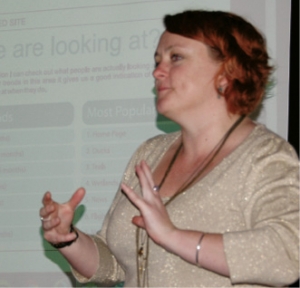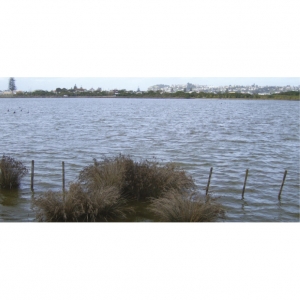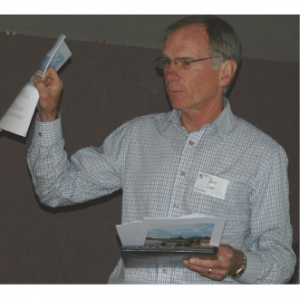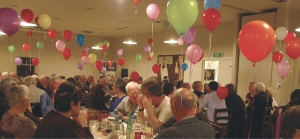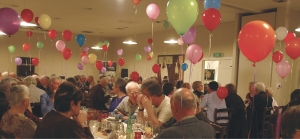Displaying items by tag: AGM
Web Feet and Websites = Ducks Unlimited
It is satisfying to see the steady rise of Ducks Unlimited website usage over the last year. Contributing factors are the great work DU are doing in Wairio and country wide, the improvements we are making to the site, word of mouth and a substantial amount of traffic directed to us by Google searches, mostly people looking for information on our webfooted friends.
Also on a rise - the use of our facebook page with now 161 members . It is a great venue to share thoughts, facts and photos on conservation and wetlands. A great place to visit and scroll through the ‘posts’ to get news on DU and other conservation organisations. We are linked with many organisations through Facebook, sharing and exchanging relevant information, as is the social networking way.
I have proudly been involved with DU’s website and other promotional projects for about three years. In that time the site has had a bit of a facelift, new additions and plenty of changes. Work continues and we look forward to further use of these resources in the coming year.
If you have not visited our website or facebook site we urge you to:
DUCKS UNLIMITED www.ducks.org.nz
QUACKCLUB (kids club) www. quackclub.co.nz and
FACEBOOK www.facebook.com/pages/Ducks-Unlimited-NZ/142374525787862
Michelle Cooper
The birds’ place – the Ahuriri estuary
An interesting visited during the AGM Conference
was the long, narrow Ahuriri estuary. We travelled by bus, so there was no chance to dip a toe in the water. With its wide range of fresh to salty, shallow to deep, and sandy to muddy habitats the estuary supports a diverse range of birds, fish, invertebrates and plant life.
It is a sanctuary for a wide variety of wading birds including Grey herons, Royal spoonbills, Pied stilts, Shags, Kingfishers and Gannets. Over 70 species of resident and migratory
waterbirds use the estuary as a feeding and resting area. Bar-tailed godwits/kuaka, Knots and Golden plovers migrate here each year from their arctic breeding grounds.
Fun, games and serious stuff at AGM
Jim Law explained what is happening at Wairio Wetland in the southern Wairarapa when he presented the following at this year’s AGM.
During 2012/2013 restoration work increased significantly and the research programmes by Victoria University’s Wellington School of Biodiversity and Restoration Ecology were expanded to include nutrient studies and hydrology.
However, of greatest interest are plans we have been pursuing for some time to reticulate water from the neighbouring Mathews lagoon (and possibly boggy Pond), under the Parera Road and into the Wairio Wetland. This would be a great boost to the health of the Wetland and assist in stripping nutrients before the water finally reaches Lake Wairarapa.
This year’s increased work cost just over $25,000 (prior year $15,000), and was once again financially supported by the Nikau Foundation, Rotary, the Pharazon Trust and the Ron Greenwood Trust and the Estates of two former DU members, Bruce McKenzie and Ron Brookes. Greater Wellington Regional council also contributed funds received under the Government’s “Fresh Start for Fresh Water” programme. In total third parties contributed $15,000, with the balance of $10,000 coming from DU resources
For the 2013/2014 year we have an even higher budge of $35,000. Key items include our normal planting, led by DU’s Trevor Thompson and again involved a number of our stakeholders, notably pupils from the local Martinborough School, students from the Taratahi Agricultural Training Centre, Rotarians and other interested parties, including of course, DU members. Good local media coverage was provided by Gill Lundie, the Wairarapa Chapter Chair. Further planting is planned for late August brings the total for the year to 4000 plants – a record!
The other main 2013/2014 item that has been completed is the construction of a bund wall around the western side of Stage 4 that has retained significant water in the Wetland. Wairio is no definitely being seen as a success story by the wider community and DU’s profile has grown accordingly.
DUNZ Annual Conference
Attendees from as far north as Auckland gathered at Brackenridge near Martinborough, Wairarapa, for DU’s annual conference and AGM. The conference included a trip to the Wairio Wetland on the eastern shores of Lake Wairarapa to catch-up on restoration progress. Delegates saw the results of recent earthworks to create a 1.2 kilometre bund wall
which has increased the open water area at the wetland providing ideal waterfowl habitat.
Those interested can check out DU’s activities on www.ducks.org.nz or better still visit Wairio Wetland on Parera Road, just south of Kahutara southern Wairarapa.
Jim Law
AGM August - at a great venue
Conference at Brackenridge Country Retreat & Spa, Martinborough, Wairarapa, Friday August 1 to Sunday August 3.
A three minute drive from the Martinborough Square, Brackenridge sits within view of
the iconic Haurangi ranges. Reminiscent of
early New Zealand station dwellings yet with welcoming stylish interiors, the cottages and
studios offer relaxing accommodation. The main reception venue with open fires and covered
verandas complete the picture.
Brackenridge can accommodate up to 64
guests in a mix of two (up to 4 guests) and four bedroom (up to 8 guests) cottages and studios. They have been very generous to DUNZ and
continental breakfast provisions plus free range eggs, plus full use of the gym, spa pool and 20m indoor heated pool.
The Spa Brackenridge is open all weekend for appointments – bookings are essential.
At this stage we are planning to have a BBQ Dinner Friday evening for those who can get there.
On Saturday the actual AGM in the morning is followed by a bus trip to Wairio wetlands with lunch at Lake Ferry Hotel.
That evening is Buffet dinner at Brackenridge
On Sunday we have organised several speakers. I visited the facilities in January and they are wonderful.
Request:
If anyone has auction items they purchased at a previous DU dinner and no longer like or want, please feel free to recycle them back into the organisation.
Or if you have other items suitable for the
auction, just email me and I will organise
someone to pick them up – This email address is being protected from spambots. You need JavaScript enabled to view it. Many thanks
Jan Abel, Administration
Predator Free New Zealand
Maybe - but not just yet
- aims for a sustainable yield
- never takes more individuals than the population can replace
- can be like the constant harvest by rabbit trappers, deer cullers, and predators
- a population can’t be affected if the yield is not declining.
- protection of a valued resource can be ineffective unless broader ecological/ sociological context is understood
- the interaction of resource/habitat/ people defines the outcome
- solutions require strategic organisation, stakeholders agreement and effective methods
- the biology and strategic organisation determine effective policy (which DU does very well).
- Forgetting that nature is on the predators’ side and ignoring the effects of natural selection
- Counting numbers removed, not numbers remaining,
- Lack of coordinated, agreed strategy
- Lack of flexibility in response to experience
- Insufficient stakeholder support.
- Inefficient tools
- Failing to deploy combination of methods
- Having no effect on fertility, immigration.
- Operator confidence, meticulous preparation, sufficient funding
- Never repeating mistakes, never giving up, so accumulating improvements, combining/switching strategies when necessary
- Landscape scale coordination
- Strong community support.
New technology
- Adds to natural mortality
- Prevents immigration
- Targets fertility
- Confirms benefit to native species.
Waipa wars – from muskets to mustelids
CONFERENCE REPORTS
Neil Candy reported that Jim Law had replaced Ken Cook as a trustee on the Waterfowl and Wetland Trust, which was “ticking along really well” with more than $500,000 in the bank.
Wetland Care
Reporting on the work of Wetland Care, Will Abel said $10,800 had been spent on three wetlands in the past year, creating about 10 acres of wetland
BITTERN
WAIRIO WETLAND
Decisive year ahead for Board
Where to from here will be the big question facing the DUNZ Board in the coming year. President Ross Cottle, in opening the formal business of the 44th AGM, said that, with an ageing membership and fewer members keen to do the work, the future direction of Ducks Unlimited would be on the Board’s agenda this year.
Measures already in place or under consideration were making Flight a two-yearly publication and changing the conference to a biennial event rather than yearly. With fewer demands to create new wetlands and maintain the established ones, the Board would be looking at other ways, including research scholarships, to support DUNZ’s goals.
Ross thanked John Cheyne, who resigned earlier in the year, for his four years as president and for raising the profile of bittern. Ross also paid tribute to those members who had passed away during the past year: Ian Pirani, Nancy Pain, Audrey Pritt, Alan Wilk and Robin Borthwick. Joyce Brooks also passed away after the AGM.
Treasurer John Bishop presented the accounts and updated members on the new rules for charitable trusts, which require entities to state their purpose. DUNZ had submitted the following mission statement: “We deliver and advocate for effective wetland restoration, development, research and education; and support the preservation of threatened waterfowl and the ethical and sustainable use of wetlands.”
Presidents Annual Report August 2015
Over the last 12 months we have had a number of highs and the odd low. Starting with the low, we have the same problem faced by DU Canada, DU USA and many other New Zealand based organisations in trying to maintain the number of members. Our membership is aging and few younger people are joining.
The DU Board have over the last four years sought advice on our future direction and increasing membership. This included aligning ourselves more closely with other similar organisations which are experiencing similar problems. Unfortunately people appear to have a greater array of demands on their time and this seems to reduce their desire to be members of organisations like DU. Declining membership naturally impacts on income. Any DU member with a magic wand and a few pearls of wisdom on the issue please let me know.
Fund raising is important for DU and the Manawatu and Wairarapa Chapters do an excellent job in organising the pre waterfowl hunting season clay target field shoot which results in a welcome donation towards our wetland projects. Our AGM weekend also generates valuable income.
DU is still involved with conservation programmes with blue duck (whio), brown teal (pateke) and white swan.
Our organisation is like an extended family with many members looking forward to the AGM to renew friendships. This is important, but could not happen without the excellent work of our Secretary Jan Able, Flight Editor Liz Brook and Web Site Manager Michelle Cooper. Your Board of Directors also work hard to achieve positive outcomes for DU. Being a Director is fun and involves working alongside a group of similar minded people. If you are interested in becoming a Director please talk to one of us.
Thank you for your on-going support. Wetlands are always going to need a helping hand.
John Cheyne, President

